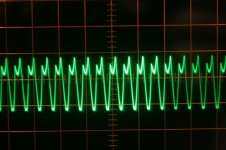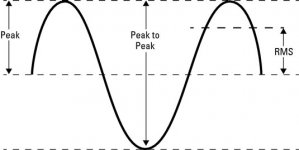I'm getting familiar with my oscilloscope and audio generator so I fed a sine wave directly to the o-scope and it looks as expected. I then fed the signal into the aux input of a late 1960's solid state integrated amp and this is what I get...

The amp works although it has all of the original components. I tested for DC at the speaker terminals prior to hooking it up to the oscilloscope and there was around .01 volts each channel.
Any idea what would cause this type of signal?

The amp works although it has all of the original components. I tested for DC at the speaker terminals prior to hooking it up to the oscilloscope and there was around .01 volts each channel.
Any idea what would cause this type of signal?
Appears to be a severely over-driven input circuit in the amplifier.
Try reducing the amplitude of the generator's output substantially.
Try reducing the amplitude of the generator's output substantially.
Last edited:
Yes, that worked. The generator has an "output level" knob which I had set to the mid-level position.
I set the output of the audio generator to .25 AC volts which is what the amp's manual specs for the input
Thank you.
Connecting the audio generator directly to the oscilloscope with a .25 VAC signal and setting the o-scope to 1cm per volt, I see a magnitude of .7 VAC with the aid of the fine tune adjustment. Does this make sense? Again, I'm just getting familiar with this equipment
Connecting the audio generator directly to the oscilloscope with a .25 VAC signal and setting the o-scope to 1cm per volt, I see a magnitude of .7 VAC with the aid of the fine tune adjustment. Does this make sense? Again, I'm just getting familiar with this equipment
If you mean 0.7V peak to peak, yes. Vp-p = 2 x Vpeak
With a function generator, try a triangle wave instead. Any distortion is more obvious.
With a function generator, try a triangle wave instead. Any distortion is more obvious.
Attachments
Last edited:
- Home
- Amplifiers
- Solid State
- Strange (to me) Sine Wave
